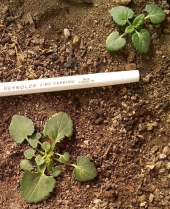With a toddler running around, I am of
course concerned about it being
water hemlock (this isn't a marshy spot, but we have a very high water table, so I'm not going assume anything). But the leaves, especially the lower leaves, seem too wide for hemlock, and the stems are green throughout, not purple. I also thought cow parsnip, but it's not nearly big
enough, and the leaves don't seem right for that, either. I found Honewort in my Peterson's guide, and for a minute I thought that was it, but the flowers don't seem right - honewort looks to have a sparser flower pattern. Flowers not the right color for wild parsnip...I'm at a loss. Anyone?









